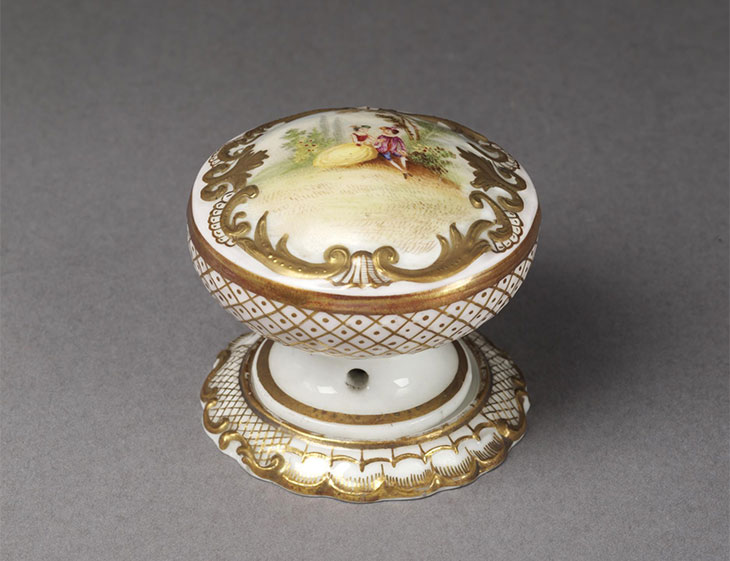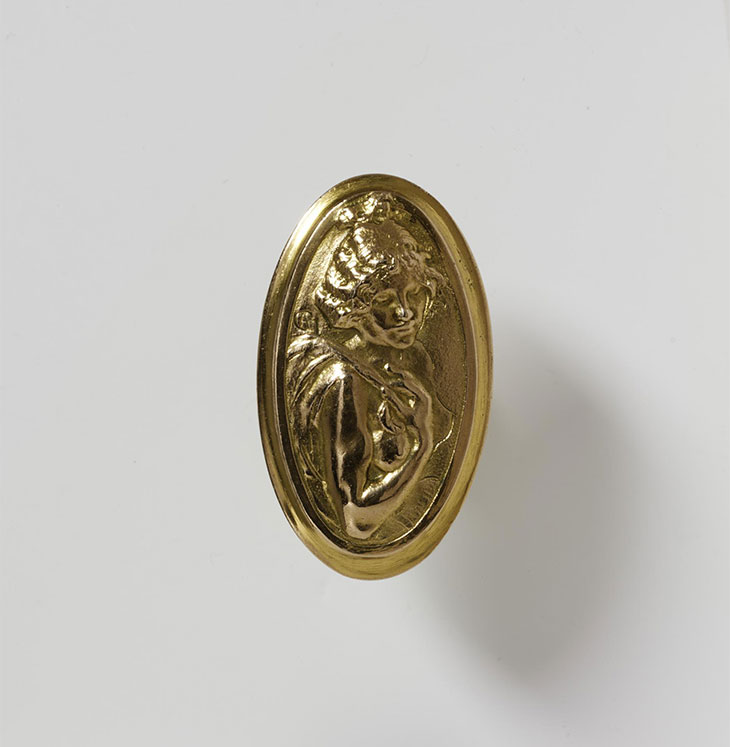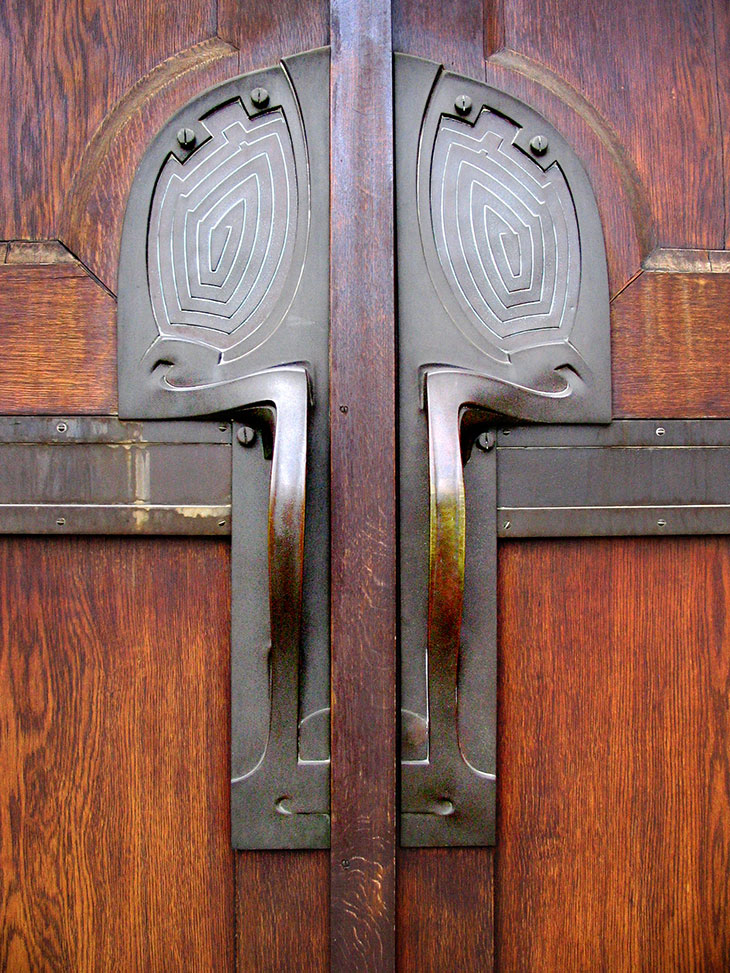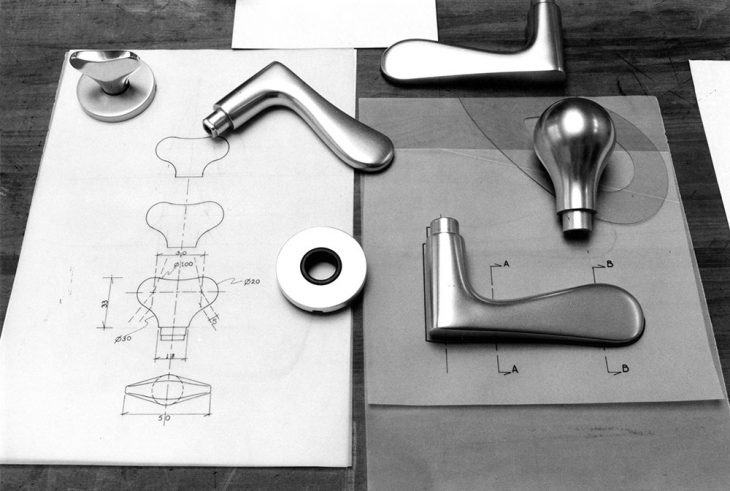We have all become suddenly more aware of the moments when we cannot avoid touching elements of public buildings. Architecture is the most physical, most imposing and most present of the arts – you cannot avoid it yet, strangely, we touch buildings at only a very few points – the handrail, perhaps a light switch and, almost unavoidably, the door handle. This modest piece of handheld architecture is our critical interface with the structure and the material of the building. Yet it is often reduced to the most generic, cheaply made piece of bent metal which is, in its way, a potent critique of the value we place on architecture and our acceptance of its reduction to a commodified envelope rather than an expression of culture and craft.
Despite their ubiquity and pivotal role in the haptic experience of architecture, door handles remain oddly under-documented. There are no serious histories and only patchy surveys of design, mostly sponsored by manufacturers. Yet in the development of the design of the door handle we have, in microcosm, the history of architecture, a survey of making and a measure of the development of design and how it relates to manufacture, technology and the body.
Door handle and rose (1833–47), manufactured by Copeland & Garrett, Stoke-on-Trent. Victoria and Albert Museum, London

For as long as there have been doors there have been door handles. They may have been primitive to start, an iron or wooden latch, a turned wooden knob, a piece of string or a leather strap. By the 18th century houses in central Europe displayed elaborate wrought-iron lever handles on their front doors, French palaces showed off with delicately cast brass versions and English houses preferred simple round or oval knobs. Manufacture was relatively local and types developed in specific regions, each with their own tastes and materials. They might be wooden knobs in the forms of beehives and small levers with wooden grips, or made out of porcelain or ceramic.
At the turn of the 20th century architects, rather than artisans, began turning their attention to door handles. The advent of art nouveau and the conception of the building as a Gesamtkunstwerk led to a proliferation of florid, organic brass handles which mirrored the fluid lines of the structure, reconceiving the handle as architectural microcosm rather than craftwork add-on. Peter Behrens, Hector Guimard, Josef Maria Olbrich, Josef Hoffmann and dozens of others created complex, intense and compact designs which mirrored the whiplash lines or geometric obsessions of their architecture. Antoni Gaudí’s designs for the delicately scrolled door handles of the Casa Batlló of 1904–06 have a stripped rococo feel and are still in production.
Door handle (c. 1900), designed by Alexandre-Louis-Marie Charpentier and manufactured by Fontaine Frères & Vaillant, Paris. Victoria and Albert Museum, London

The next big shift came with the application of functionalist sensibilities to the handle. The modernists, notably the designers at the Bauhaus, understood that each element of a building might express the ideas embodied in the whole and in the door handle they found the perfect tool for reducing a building to its most minimal form. Henry van de Velde, who founded the design school in Weimar that would become the Bauhaus, had set the ball rolling but it was the Bauhaus’s first director, Walter Gropius, who would design the handle that became the most complete expression of modernism in 1923. Based on a square and a cylindrical section the lever is an amalgam of the platonic geometry of modernity, of constructivism and suprematism. It looks like a component in a machine but is, of course, a handmade object. It was one of the first products to be marketed by the Bauhaus in an effort to raise funds and achieved some limited success – the handles can still be found on public buildings from the era across Germany. It became a kind of handheld modernist manifesto, a radical, stripped-down design that worked, looked elegant and felt comfortable. Another Bauhaus designer, Wilhelm Wagenfeld, designed a number of handles based on similar tectonic games and Mies van der Rohe also tried his hand at a series of surprisingly ergonomic handles that eschewed the geometric rigour of his buildings.
Door handles on the entrance to the Nietzsche-Archiv in Weimar, designed by Henry van de Velde in 1903. Photo: Milena/Wikimedia Commons (CC BY-SA 3.0)

Arguably the most influential, although not necessarily familiar, door handle was designed not by an architect but by a philosopher – albeit one with an engineering degree. Ludwig Wittgenstein’s handle for the house he designed for his sister in Vienna in 1928 is a simple bent metal bar with one of the pair kinked to accommodate a portion of frame for the French doors it was designed for. It apparently took him a year to design (he spent two years on the radiators), but that simple bent bar morphed into the bent tube which is perhaps the most ubiquitous and generic of all modern designs.
As factories retooled from making weapons to consumer products after the Second World War, handgun-sized handles proved an easy conversion. The industrial miracles in post-war Germany, France and Italy led to an outpouring of new designs and the growth of the companies that still dominate top-end production. From Gio Ponti to Arne Jacobsen, every decent architect and industrial designer had a go at a handle. Many remain in production, quite possibly unsurpassed. There was a brief renaissance in door-handle design in the postmodern era, when it became a ‘typology’ and hundreds of ironic or referential designs were launched only to disappear again with fashion. Handles became rather like chairs, with consumers and architects wondering how many more designs the world actually needed. Nevertheless, exquisite and unexpected designs occasionally emerge and each generation finds something new in the everyday. Architects and designers such as 6a, Jasper Morrison and Mark Pimlott have reinterpreted traditional types, while Aldo Bakker has exaggerated existing, familiar forms to create something new and sculptural.
Series 1144 door handle (1990), produced by FSB for Jasper Morrison Ltd. Photo: Tim Rautert

And yet. Despite the plethora of thoughtful designs, almost every door handle you will see today will be cheap and ill-considered. Modernism managed to make a fetish of the handle, but economic reality has always proved a formidable obstacle.


